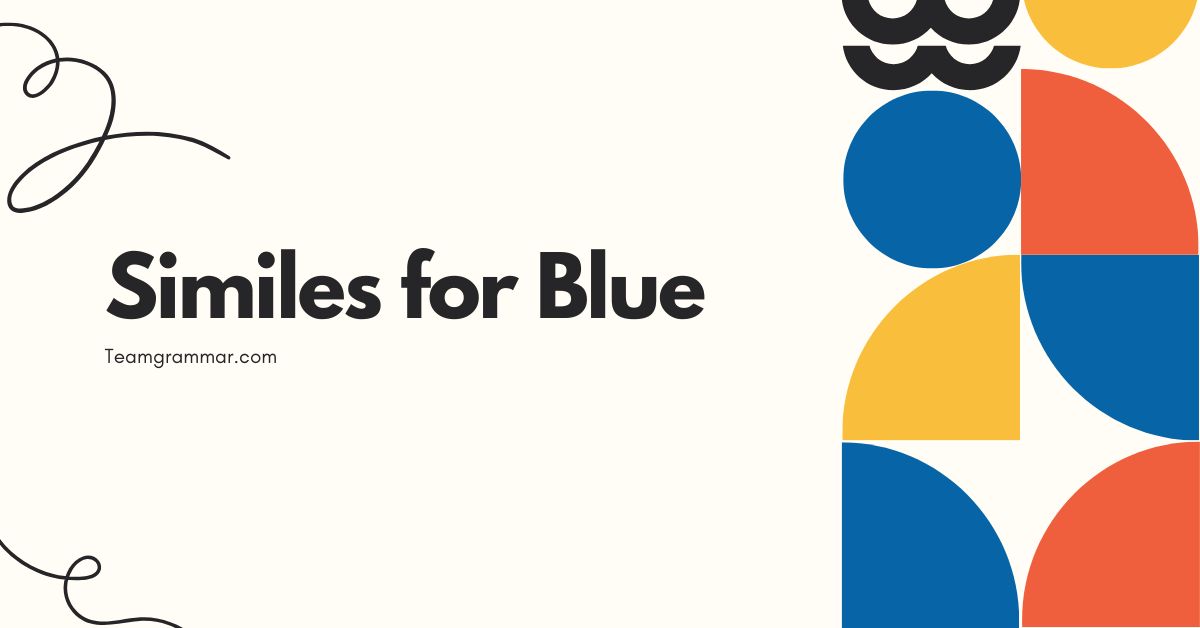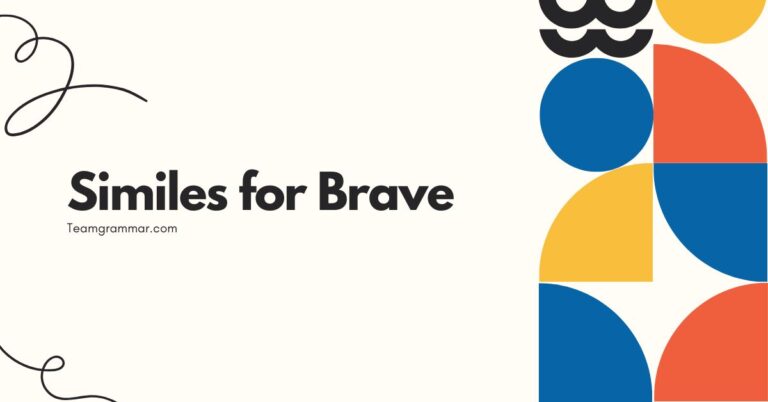35 Similes for Blue: Enhancing Your Descriptive Language
Similes are powerful tools in the English language, allowing us to create vivid and engaging descriptions by comparing one thing to another. When it comes to describing the color blue, a wide range of similes can evoke different shades, moods, and contexts.
Mastering these similes not only enriches your vocabulary but also enhances your ability to communicate effectively and creatively. This article will explore various similes for blue, providing examples, usage rules, and practical exercises to help you incorporate them seamlessly into your writing and speech.
Whether you’re a student, writer, or language enthusiast, this guide will deepen your understanding and appreciation of descriptive language.
Table of Contents
- Introduction
- Definition of Simile
- Structural Breakdown of Similes
- Types and Categories of Blue
- Examples of Similes for Blue
- Usage Rules for Similes
- Common Mistakes When Using Similes
- Practice Exercises
- Advanced Topics in Similes
- Frequently Asked Questions
- Conclusion
Definition of Simile
A simile is a figure of speech that compares two unlike things using the words “like” or “as.” The primary function of a simile is to enhance description by drawing a parallel between something familiar and something less known, thereby creating a more vivid and relatable image in the reader’s mind. Similes are essential in both literary and everyday contexts, adding depth and color to language.
Similes fall under the broader category offigurative language, which includes metaphors, personification, and hyperbole. Unlike metaphors, which directly equate two things, similes acknowledge the comparison through the use of “like” or “as.” This distinction is crucial for understanding the nuances of descriptive writing.
The effectiveness of a simile lies in its ability to evoke sensory details and emotional responses in the audience.
In various contexts, similes serve different purposes. In literature, they can create atmosphere, develop character, and convey complex themes.
In everyday conversation, they help us explain concepts, express feelings, and make our speech more engaging. The versatility of similes makes them an indispensable tool for effective communication.
Structural Breakdown of Similes
The basic structure of a simile consists of three main components: thesubject, thelinking word(like or as), and thecomparative element. The subject is the thing being described, while the comparative element is the thing to which it is being compared.
The linking word establishes the relationship between the two.
Consider the simile: “The ocean wasas blue as sapphire.” Here, “ocean” is the subject, “as” is the linking word, and “sapphire” is the comparative element. This structure allows for a clear and direct comparison, making the description more impactful.
Understanding this structure is crucial for creating effective and grammatically correct similes.
Variations in simile structure may involve more complex phrasing or the inclusion of additional descriptive words. For example, “His eyes werelike the deep, endless blue of the summer sky” adds more detail to both the subject and the comparative element, resulting in a richer and more evocative simile.
The key is to maintain clarity while enhancing the descriptive power of the comparison.
Types and Categories of Blue
The color blue encompasses a wide range of shades and hues, each with its own unique characteristics. Understanding these variations is essential for crafting accurate and effective similes.
Here are some common types of blue:
- Sky Blue: A light, airy blue reminiscent of a clear daytime sky.
- Navy Blue: A dark, deep blue often associated with uniforms and the sea.
- Royal Blue: A rich, vibrant blue with a regal quality.
- Azure: A bright, vivid blue, often used to describe the color of the Mediterranean Sea.
- Cobalt Blue: An intense, slightly purplish blue.
- Teal: A blue-green color, often associated with tropical waters.
- Indigo: A deep, dark blue, almost bordering on violet.
Each of these shades can evoke different feelings and associations, making them suitable for different types of similes. For example, sky blue might be used in similes describing lightness and freedom, while navy blue might be used to convey depth and authority.
The choice of blue depends on the specific context and the desired effect.
Examples of Similes for Blue
Here are several examples of similes for the color blue, categorized by their comparative elements. Each category aims to highlight different aspects and associations of the color blue.
Sky-Related Similes
Sky-related similes often evoke feelings of openness, freedom, and tranquility. They are particularly effective for describing light and airy shades of blue.
The following table provides a variety of examples.
| Simile | Explanation |
|---|---|
| As blue as a summer sky | Refers to the clear, unclouded blue of a summer day. |
| Like the endless blue of the heavens | Emphasizes the vastness and limitlessness of the sky. |
| As blue as the morning firmament | Describes the fresh, bright blue of the early morning sky. |
| Like the deep blue of twilight | Evokes the darker, more mysterious blue of the evening sky. |
| As blue as a jay’s wing against the sky | Combines the color of a bird’s wing with the expansive sky. |
| Like a sapphire set against the dawn | Compares the blue to a precious gem, enhancing its beauty and value. |
| As blue as the sky after a storm | Describes the clear, pure blue that emerges after a storm clears. |
| Like the fading blue of the evening horizon | Captures the subtle, changing blue as daylight fades into night. |
| As blue as the heavens on a cloudless day | Highlights the pristine and unobstructed view of the sky. |
| Like the blue of a distant mountain range | Evokes the hazy, muted blue of mountains seen from afar. |
| As blue as the sky reflected in a still pond | Describes the serene and mirrored image of the sky. |
| Like the blue of the atmosphere at high altitude | Refers to the intense, pure blue seen at great heights. |
| As blue as the dome of the sky above | Emphasizes the overarching and encompassing nature of the sky. |
| Like the blue of a clear, crisp winter sky | Captures the sharp, vibrant blue of a cold winter day. |
| As blue as the sky just before sunrise | Describes the anticipation and subtle color changes before dawn. |
| Like the blue of the sky during a meteor shower | Adds a sense of wonder and spectacle to the description. |
| As blue as the sky seen through a telescope | Refers to the magnified and enhanced view of the sky. |
| Like the blue of the sky on a hot summer afternoon | Evokes the lazy and hazy blue of a warm day. |
| As blue as the sky after a light snowfall | Describes the fresh and clean blue following a snowfall. |
| Like the blue of the sky during a solar eclipse | Captures the unusual and dramatic appearance of the sky. |
| As blue as the sky during the aurora borealis | Adds a sense of magic and otherworldly beauty to the description. |
| Like the blue of the sky in a desert landscape | Highlights the contrast between the arid earth and the expansive sky. |
| As blue as the sky just after a lunar eclipse | Describes the subtle changes in color following the eclipse. |
| Like the blue of the sky during a full moon | Captures the soft and ethereal blue under the moonlight. |
Water-Related Similes
Water-related similes often evoke feelings of depth, mystery, and fluidity. They are suitable for describing various shades of blue, from the light blue of tropical waters to the deep blue of the ocean depths.
Here are some examples.
| Simile | Explanation |
|---|---|
| As blue as the deep ocean | Refers to the intense, dark blue of the ocean depths. |
| Like the clear blue of a tropical sea | Evokes the bright, vibrant blue of tropical waters. |
| As blue as a mountain lake | Describes the pristine, clear blue of a high-altitude lake. |
| Like the shimmering blue of a lagoon | Captures the reflective and sparkling quality of a lagoon. |
| As blue as the depths of the Mariana Trench | Highlights the extreme depth and darkness of the ocean. |
| Like the blue of the Caribbean Sea | Refers to the distinctive turquoise-blue color of the Caribbean. |
| As blue as a glacial river | Describes the cold, icy blue of a river fed by glaciers. |
| Like the blue of the Mediterranean at midday | Evokes the intense, sunlit blue of the Mediterranean Sea. |
| As blue as a deep-sea fish | Compares the color to the unique hues found in deep-sea creatures. |
| Like the blue of a pristine spring | Captures the clear, pure blue of a natural spring. |
| As blue as the water in a cenote | Refers to the unique, deep blue of a cenote (sinkhole). |
| Like the blue of a swimming pool on a sunny day | Evokes the bright, inviting blue of a pool under sunlight. |
| As blue as the waters surrounding a coral reef | Describes the vibrant, diverse blue around a coral reef. |
| Like the blue of the Arctic Ocean | Captures the cold, icy blue of the Arctic waters. |
| As blue as the wake of a ship at sea | Refers to the frothy, vibrant blue left behind by a moving ship. |
| Like the blue of the ocean seen from space | Highlights the vastness and depth of the ocean from a cosmic perspective. |
| As blue as a deep, clear well | Evokes the cool, dark blue of a well. |
| Like the blue of the Nile River at sunset | Captures the warm, golden hues mixed with the blue of the water. |
| As blue as the water in a geyser pool | Describes the unique, mineral-rich blue of geyser waters. |
| Like the blue of a waterfall cascading down rocks | Evokes the dynamic and flowing blue of a waterfall. |
| As blue as the water in a fjord | Refers to the deep, serene blue of a fjord. |
| Like the blue of a hidden cove | Captures the secluded and mysterious blue of a cove. |
| As blue as the water on a calm lake | Describes the peaceful, reflective blue of a calm lake. |
| Like the blue of a river delta | Evokes the complex, interwoven blue of a river delta. |
Gemstone-Related Similes
Gemstone-related similes add a sense of preciousness and brilliance to the description of blue. They are particularly effective for highlighting the beauty and value of something.
Here are some examples.
| Simile | Explanation |
|---|---|
| As blue as a sapphire | Refers to the deep, rich blue of a sapphire gemstone. |
| Like the vibrant blue of a turquoise stone | Evokes the bright, opaque blue of turquoise. |
| As blue as a lapis lazuli | Describes the deep, celestial blue of lapis lazuli. |
| Like the shimmering blue of an aquamarine | Captures the light, sea-green blue of aquamarine. |
| As blue as a blue diamond | Highlights the rare and precious blue of a diamond. |
| Like the deep blue of an azurite crystal | Refers to the intense, almost electric blue of azurite. |
| As blue as a tanzanite gem | Describes the unique, trichroic blue of tanzanite. |
| Like the blue of a kyanite stone | Evokes the striated, crystalline blue of kyanite. |
| As blue as an opal with blue flashes | Refers to the iridescent, multi-colored flashes within an opal. |
| Like the deep blue of a spinel | Captures the vibrant, pure blue of spinel. |
| As blue as a Benitoite | Describes the rare, barium titanium silicate mineral, Benitoite. |
| Like the blue of a Grandidierite | Evokes the bluish-green color of Grandidierite, one of the rarest gemstones. |
| As blue as a Dumortierite | Refers to the varying shades of blue found in Dumortierite. |
| Like the blue of a Hauyne | Captures the intense blue color of Hauyne, a rare mineral. |
| As blue as a Cavansite | Describes the deep blue color of Cavansite crystals. |
Mood-Related Similes
Mood-related similes use blue to evoke certain emotions or states of mind. These similes can add depth and emotional resonance to your descriptions.
Here are some examples.
| Simile | Explanation |
|---|---|
| As blue as my mood on a rainy day | Refers to the feeling of sadness or melancholy. |
| Like the blues of a sad song | Evokes feelings of sorrow and longing. |
| As blue as the feeling of isolation | Describes the loneliness and detachment. |
| Like the blue of a quiet, reflective moment | Captures a sense of peace and introspection. |
| As blue as the depths of despair | Highlights the intense sadness and hopelessness. |
Nature-Related Similes
Nature-related similes use elements from the natural world to describe different shades of blue. These similes are particularly effective for conveying the beauty and serenity of nature.
| Simile | Explanation |
|---|---|
| As blue as a bluebell flower | Refers to the delicate, vibrant blue of bluebell blossoms. |
| Like the blue of a butterfly’s wing | Evokes the intricate and colorful patterns of butterfly wings. |
| As blue as a robin’s egg | Describes the soft, gentle blue of a robin’s eggshell. |
| Like the blue of a peacock’s feather | Captures the iridescent and majestic blue of peacock feathers. |
| As blue as the berries on a juniper bush | Refers to the deep, waxy blue of juniper berries. |
| Like the blue of a forget-me-not flower | Evokes the small, delicate blue petals of forget-me-nots. |
| As blue as a bluebird’s plumage | Describes the bright, striking blue of a bluebird’s feathers. |
| Like the blue of a hydrangea bloom | Captures the varied shades of blue found in hydrangea flowers. |
| As blue as a dragonfly’s body | Refers to the shimmering, metallic blue of a dragonfly’s body. |
| Like the blue of a glacier ice | Evokes the cold, intense blue of glacial ice formations. |
| As blue as the shadows in a snowdrift | Describes the subtle, cool blue tones found in snow shadows. |
| Like the blue of a mountain lupine | Captures the vibrant blue of lupine flowers growing in mountainous regions. |
| As blue as the feathers of a macaw | Refers to the bright, exotic blue of macaw feathers. |
| Like the blue of the sea holly | Evokes the unique, spiky blue of sea holly plants. |
Usage Rules for Similes
When using similes, it’s important to follow certain rules to ensure clarity and effectiveness. Here are some key guidelines:
- Use “like” or “as”: Always include one of these words to explicitly indicate the comparison.
- Compare unlike things: The elements being compared should be different enough to make the comparison interesting and insightful.
- Ensure clarity: The comparison should be easily understood by the reader or listener. Avoid obscure references that might confuse the audience.
- Maintain consistency: The simile should fit the tone and style of the writing or speech. Avoid jarring or inappropriate comparisons.
- Avoid clichés: Try to come up with original similes rather than relying on overused phrases.
Consider these examples:
- Correct: The water was as blue as a sapphire.
- Incorrect: The water was a sapphire. (This is a metaphor, not a simile.)
By following these rules, you can create similes that enhance your descriptions and engage your audience effectively.
Common Mistakes When Using Similes
Even experienced writers can make mistakes when using similes. Here are some common errors to avoid:
- Confusing similes with metaphors: Remember that similes use “like” or “as,” while metaphors directly equate two things.
- Using clichés: Overused similes can make your writing sound unoriginal and dull.
- Creating illogical comparisons: The comparison should make sense and be relevant to the context.
- Being too vague: The simile should provide enough detail to create a clear and vivid image.
Here are some examples of common mistakes and how to correct them:
| Incorrect | Correct | Explanation |
|---|---|---|
| The sky was a blue sapphire. | The sky was as blue as a sapphire. | The first sentence is a metaphor, while the second is a simile. |
| The water was as blue as the sky. | The water was as blue as a tropical lagoon. | The second simile is more specific and evocative. |
| The color was like nothing. | The color was like the deep blue of the ocean depths. | The second simile provides a clear and meaningful comparison. |
By being aware of these common mistakes, you can improve the quality and effectiveness of your similes.
Practice Exercises
Test your understanding of similes with these practice exercises. Fill in the blanks with appropriate comparative elements to complete the similes.
| Question | Answer |
|---|---|
| 1. The paint was as blue as __________. | 1. The paint was as blue as a robin’s egg. |
| 2. His eyes were like __________. | 2. His eyes were like the deep ocean. |
| 3. The fabric was as blue as __________. | 3. The fabric was as blue as a hydrangea bloom. |
| 4. The sky was like __________. | 4. The sky was like the heavens on a clear day. |
| 5. The gemstone was as blue as __________. | 5. The gemstone was as blue as a sapphire. |
| 6. Her dress was like __________. | 6. Her dress was like the blue of the Caribbean Sea. |
| 7. The water in the pool was as blue as __________. | 7. The water in the pool was as blue as a mountain lake. |
| 8. The ink was like __________. | 8. The ink was like the dark blue of twilight. |
| 9. The flower was as blue as __________. | 9. The flower was as blue as a bluebell. |
| 10. His mood was like __________. | 10. His mood was like the blues of a sad song. |
Exercise 2: Rewrite the following sentences using similes to describe the color blue.
| Original Sentence | Rewritten Sentence with Simile |
|---|---|
| 1. The car was very blue. | 1. The car was as blue as a summer sky. |
| 2. Her scarf was a bright blue. | 2. Her scarf was like the vibrant blue of a turquoise stone. |
| 3. The water was a deep blue. | 3. The water was as blue as the deep ocean. |
| 4. The bird had blue feathers. | 4. The bird’s feathers were like the blue of a peacock’s feather. |
| 5. The house had blue walls. | 5. The house had walls as blue as a robin’s egg. |
| 6. The dress was a captivating shade of blue. | 6. The dress was a captivating shade, like the shimmering blue of an aquamarine. |
| 7. The lake shimmered with a blue hue. | 7. The lake shimmered with a blue hue, as blue as a mountain lake reflecting the sky. |
| 8. The room was painted in a calming blue tone. | 8. The room was painted in a calming blue tone, like the blue of a quiet, reflective moment. |
| 9. The sky at dusk was a mesmerizing blue. | 9. The sky at dusk was a mesmerizing blue, as blue as the deep blue of twilight. |
| 10. The artist used an intense blue in her painting. | 10. The artist used an intense blue in her painting, like the vibrant blue of a cobalt pigment. |
Advanced Topics in Similes
For advanced learners, exploring more complex aspects of similes can further enhance their writing skills. This includes understanding the use of extended similes, mixed similes, and the cultural context of similes.
Extended similes involve developing a comparison over several sentences or paragraphs, allowing for a more detailed and nuanced description. This technique can be particularly effective in creating vivid imagery and conveying complex ideas.
Mixed similes combine elements from different areas of comparison, creating a more unconventional and thought-provoking effect. While they can be effective, it’s important to use them carefully to avoid confusing or jarring the reader.
Understanding the cultural context of similes is also important, as certain comparisons may have different meanings or associations in different cultures. Being aware of these nuances can help you use similes more effectively and avoid unintentional offense.
Frequently Asked Questions
- What is the difference between a simile and a metaphor?
A simile compares two unlike things using “like” or “as,” while a metaphor directly equates two things without using those words. For example, “The sky is like a blue canvas” is a simile, while “The sky is a blue canvas” is a metaphor.
- Why are similes important in writing?
Similes enhance descriptions, engage the reader, and make writing more vivid and memorable. They help to create a clearer and more relatable image in the reader’s mind by drawing comparisons to familiar things.
- How can I avoid using clichés in my similes?
To avoid clichés, try to think of original and unexpected comparisons. Consider using sensory details and specific examples to make your similes more unique and impactful. Brainstorming and experimenting with different ideas can also help.
- Can a simile be too complex?
Yes, a simile can be too complex if it is difficult to understand or if it distracts from the main point of the writing. The comparison should be clear and relevant to the context. If a simile is too convoluted, it may be better to simplify it or choose a different comparison altogether.
- How do I choose the right comparative element for a simile?
The right comparative element depends on the specific context and the desired effect. Consider the qualities you want to emphasize and choose a comparative element that shares those qualities. Experiment with different options to see which one works best.
- What role do similes play in poetry?
Similes play a significant role in poetry by adding depth, imagery, and emotional resonance to the verses. They help poets convey complex emotions and ideas in a concise and evocative way, enhancing the overall impact of the poem.
- Are similes only used in literature?
No, similes are used in various forms of communication, including everyday conversation, speeches, and marketing materials. They are a versatile tool for enhancing descriptions and making language more engaging in any context.
- How can I improve my ability to create effective similes?
To improve your ability to create effective similes, practice regularly and pay attention to the similes used by other writers. Read widely, expand your vocabulary, and experiment with different comparisons. The more you practice, the better you will become at crafting impactful similes.
- Is it okay to use multiple similes in a single paragraph?
Yes, it is acceptable to use multiple similes in a single paragraph, but it’s important to do so judiciously. Overusing similes can make your writing seem cluttered or forced. Ensure that each simile adds value and contributes to the overall clarity and impact of the paragraph.
- Can similes be used to describe abstract concepts?
Yes, similes can be used to describe abstract concepts by comparing them to concrete or tangible things. This can help make abstract ideas more accessible and easier to understand. For example, “Love is like a warm blanket on a cold day” uses a concrete image to describe an abstract emotion.
Conclusion
Mastering similes for the color blue can significantly enhance your descriptive writing and communication skills. By understanding the structure, types, and usage rules of similes, you can create more vivid and engaging descriptions that resonate with your audience.
Remember to avoid common mistakes, practice regularly, and explore advanced topics to further refine your skills.
The ability to effectively use similes is a valuable asset for writers, students, and anyone who wants to communicate more clearly and creatively. As you continue to practice and experiment with different similes, you will develop a deeper appreciation for the power and beauty of descriptive language.
Keep exploring new comparisons and refining your skills to unlock the full potential of similes in your writing and speech.







